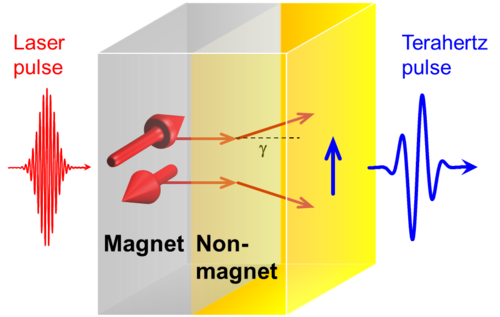2. Development of new spectroscopic tools
To answer the questions posed above, we develop new spectroscopic tools and methods, with a special focus on pulsed THz radiation with frequencies ranging from ~0.3 to 30 THz. We currently work on extending THz spectroscopy to magnetic solids and soft matter (such as liquids). For instance, to reveal the coupling between crystal lattice and electron spins, we make use of the scheme shown above: we use an intense THz pulse to resonantly excite optical phonons and probe the resulting impact on the spin system by a delayed optical probe pulse.
To probe and identify the inital steps of the ultrafast transport of electron spins, we have recently developed the scheme shown in Figure 2. A femtosecond optical laser pulse is used to launch transport of electron spins (thick red arrows) from a ferromagnetic into a nonmagnetic metal layer. In the nonmagnetic metal, spin-up and spin-down electrons are deflected in opposite directions by an angle γ. This only recently discovered inverse spin Hall effect results in a transverse charge current (blue arrow), acting as a source of a THz electromagnetic pulse. Measurement of the THz electric field allows us to reconstruct of the spin transport dynamics.
Finally, to interpret our experimental results, we work out simple toy models. For example, we have recently modeled the transport experiment above using spin transport equations and Maxwell's equations.


